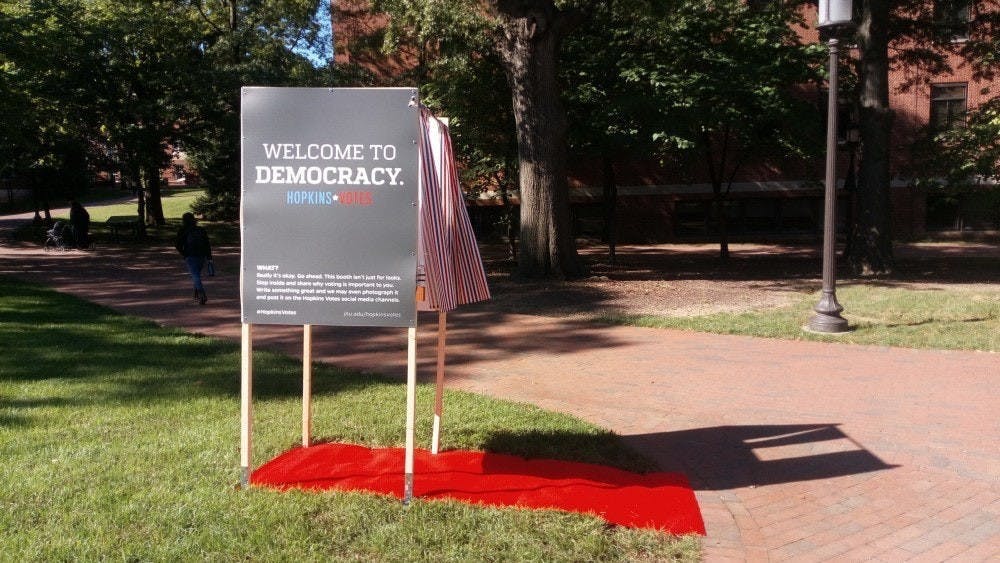There’s a lot of talk about low turnout among young voters, especially in the wake of Super Tuesday. Bernie Sanders’ campaign counted on a wave of new young voters heading to the polls and carrying him to victory — a wave that failed to appear, even though Sanders did overwhelmingly win among young voters.
So why couldn’t Sanders get students to the polls? The fact is that an “exciting” candidate is still not enough to dramatically increase the rate at which young people vote, because political apathy isn’t the source of the problem.
The problem is that college students face unique hurdles in registering to vote.
The Maryland legislature recently had the opportunity to pass the Student Voter Empowerment Act, which would have increased young voter participation and fostered civic engagement. This bill would have required institutions to create and implement a plan to teach students about voter registration. It would have also opened polling locations on large campuses like Hopkins. We’re disappointed that the legislature did not seize this opportunity.
Registering to vote may seem simple, but for newly independent college students, the entire process can seem daunting and difficult to navigate.
Young people face specific challenges when trying to vote. As a report from Ideas42 explains, it is not students’ age that is the barrier to political participation, but rather the unfamiliarity of the process. Our turnout is low because we’re new voters, not just because we’re young voters.
The first set of barriers students face is rooted in our inexperience with filling out paperwork. Official government forms like the voter registration form can be intimidating. We’re afraid making a mistake will have harsh consequences, the same way messing up on a tax return could. No one ever taught us how to register, so questions like what address to use loom large and unanswered.
Beyond confusion about the process, college students are just getting used to the idea of being adults. We’re learning to manage schoolwork and new responsibilities, like paying credit card bills or making doctor’s appointments, while living independently. Our days are packed with class, jobs, studying and extracurricular activities. It’s not simple to find the time and energy to figure out registering to vote. And when it comes to actually voting, it’s harder for us to get to the polls than it is for other age groups that have easier access to transportation.
Furthermore, students often feel unqualified to vote. The Ideas42 report describes how college students tend to think of voting as a multiple-choice test, one that you can “fail.” Unsure of how to best “study,” many students end up not voting at all. Voting isn’t a part of our identities the way it is for those who have voted for years, so we’re less motivated to vote.
These are just some of the myriad barriers that college students like us face. Personally, as out-of-state students, we were also unsure about whether we had to re-register with our campus address (If you’re wondering, you can likely register in either location. Check the Campus Vote Project to learn about your state’s policy).
You might think that these barriers are small. You may even be right. However, it’s our perception of these barriers that matters, not their actual feasibility.
When you’re in college and you have never voted before, have never filled out an official form without your parents and have no idea how long the process will take or what it will entail, registering to vote can feel overwhelming. College administrators can change this perception and foster an environment where voting is the norm. The Maryland legislature should have passed the Student Voter Empowerment Act to facilitate this process.
Colleges, including Hopkins, are having some success with increasing the rates at which their students register and vote. Thanks to the efforts of the Hopkins Votes campaign, 44.8 percent of the Hopkins student body voted in the 2018 midterm elections, up from around 14.4 percent in 2014.
While this increase is impressive, it is still nowhere near full student voter participation. Hopkins would have been able to increase those numbers in coming years with the guidance of a Student Voting Coordinator, a position the Student Voter Empowerment Act would have created on campuses throughout Maryland.
Registering students ensures that young people are represented in the political process. Low young voter turnout today means our generation is not making our voice heard politically. If we increased this number, we could ensure that policies better reflect the needs of all people.
We’re disappointed the Maryland legislature didn’t pass the Student Voter Empowerment Act to increase voter turnout among college students in Maryland. Even though the legislature isn’t doing its part, we still do our part as students to help make student- voting the norm.
Take a few minutes of your busy day to head to TurboVote to register or update your registration! Our vote will decide the future that we live in, so it is imperative that we have a say.
Samantha Gould is a junior International Studies major from Glendale, Calif. Amanda Kaufman is a senior International Studies major from Los Angeles, Calif. They both work for the Maryland Public Interest Research Group





